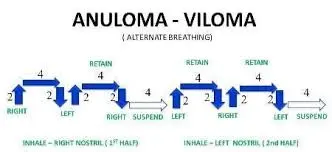Did you know that every day, we take in and let out our breath around 20,000 times? That is a whole lot of breathing going on! But have you ever thought about how each of those breaths can be super powerful for our well-being? That is where Anulom vilom pranayama is this ancient practice that’s been around for ages, as old as the towering Himalayan mountains. Anulom Vilom is this simple yet incredibly amazing technique where you breathe in and out through one nostril at a time. And let me tell you, itis way more than just some fancy breathing trick. Anulom Vilom is like finding a secret stash of awesome benefits waiting to be uncovered.
In this blog, we are read what is anulom vilom,anulom meaning,vilom means,anulom vilom steps,benefits of anulom vilom,how to do anulom vilom etc.
Contents
What is Anulom Vilom Pranayama?
Anulom Vilom, also known as Nadi Shodhana Pranayama or alternate nostril breathing, is a yogic breathing technique originating from ancient India. In Sanskrit, anulom means“with the grain” or “natural,” while “vilom” means “against the grain” or “opposite.”Anulom Vilom Pranayama involves breathing in through one nostril while blocking the other, then switching nostrils and exhaling. This process is repeated alternately, called “alternate nostril breathing.”
Anulom Vilom Pranayama is often practiced as part of a broader yoga or meditation routine, but it can also be done independently for its specific benefits. It is accessible to people of all ages and fitness levels and can be modified to suit individual needs. With regular practice, Anulom Vilom Pranayama can become a valuable tool for managing stress, enhancing focus, and cultivating inner peace.
Types of Anulom Vilom Pranayama

- Basic Anulom Vilom Pranayama: This is the traditional form of alternate nostril breathing where you use your fingers to block one nostril while inhaling through the other, then switch nostrils to exhale. It involves a smooth and rhythmic flow of breath, typically done in a seated position with the spine erect.
- Extended Anulom Vilom Pranayama: In this variation, you prolong the duration of inhalation, retention, and exhalation. This helps to deepen the breath and enhance the benefits of the practice. It requires focus and control of the breath, gradually increasing the duration as you become more comfortable.
- Kapalabhati Anulom Vilom Pranayama:- This combines the rapid breathing technique of Kapalabhati with alternate nostril breathing. You alternate between rounds of Kapalabhati and Anulom Vilom, which can help to energize the body, clear the mind, and improve respiratory function.
- Counted Anulom Vilom Pranayama: Here, you incorporate a specific count for each stage of the breath, such as inhaling for a count of four, holding the breath for a count of four, exhaling for a count of four, and holding the breath out for a count of four. This helps to regulate the breath and deepen relaxation.
Check Other Blogs :- 4 types of pratyahara
Benefits of Anulom Vilom

Physical benefits of Anulom Vilom Pranayama
- Deep breathing enhances lung function and oxygen intake, beneficial for asthma and bronchitis.
- Strengthens respiratory muscles, expands lung capacity, and improves endurance.
- Reduces blood pressure and heart rate, enhances circulation, and lowers the risk of heart disease.
- Aids in toxin removal, stimulates lymphatic drainage, and supports liver function.
- Massages abdominal organs, promotes digestion and alleviates gastrointestinal discomfort.
- Alleviates chronic pain conditions like migraines and arthritis by reducing inflammation.
Mental and Emotional Benefits of Anulom Vilom Pranayama
- Anulom Vilom activates the parasympathetic nervous system, promoting relaxation and reducing stress levels.
- Enhances cognitive function, clears mental clutter, and sharpens focus through mindful awareness.
- Regulates emotions, fosters emotional resilience, and cultivates a sense of calm and stability.
- Anxiety and depression relief: Reduces symptoms of anxiety and depression, promotes emotional well-being, and enhances mood.
- Clears the mind, increases mental clarity, and improves decision-making and problem-solving abilities.
Instructions for Practicing Anulom Vilom Steps

- Preparation: Find a comfortable seated position. You can sit cross-legged on the floor or a chair with your spine comfortably upright. Relax your shoulders and place your hands on your knees or in a comfortable position on your lap.
- Nasal Cleansing: Before beginning Anulom Vilom, it’s beneficial to clear your nasal passages. You can do this by gently blowing your nose or using a neti pot to rinse your nasal passages with saline solution.
- Hand Position: Rest your left hand on your left knee with the palm facing upward. Use your right hand to perform the breathing technique.
- Alternate Nostril Breathing: Bring your right hand up to your face. Use your right thumb to gently close your right nostril and your right ring finger or pinky to close your left nostril.
- Inhalation: Close your right nostril with your thumb and inhale deeply through your left nostril. Fill your lungs completely with air, but without straining.
- Retention: Once you’ve inhaled fully, close your left nostril with your ring finger or pinky and hold your breath for a brief moment.
- Exhalation: Release your right nostril and exhale slowly and completely. Empty your lungs of air through your right nostril.
- Inhalation (Other Nostril): Keep your left nostril closed and inhale through your right nostril. Fill your lungs with air completely and evenly.
- Retention: Close your right nostril and hold your breath for a moment.
- Exhalation (Other Nostril): Release your left nostril and exhale slowly and completely through your left nostril.
- Repeat: Continue this alternating pattern of inhalation, retention, and exhalation for several rounds. Aim for a smooth, steady rhythm without rushing the breath.
- Ending: After completing the desired number of rounds, release both nostrils and breathe naturally for a few moments. Observe any sensations in your body and mind.
Anulom Vilom Pranayama Breathing Technique:

- Visual Technique: Close your eyes and visualize the breath as it moves through each nostril. Imagine a stream of pure, cleansing energy entering your body as you inhale through one nostril, and visualize any tension or impurities leaving your body as you exhale through the other nostril. This visualization can enhance focus and deepen relaxation during the practice.
- Mantra Technique: Incorporate a calming mantra or affirmation into your practice. As you inhale through one nostril, silently repeat a soothing phrase to yourself, such as “I am calm and centered.” As you exhale through the other nostril, release any tension or negative thoughts, repeating the mantra silently with each breath. This technique helps to synchronize breath with intention, promoting a sense of peace and balance.
- Counting Technique: Use a counting method to regulate the duration of each breath. Inhale deeply through one nostril while silently counting to a specific number (e.g., four counts), then hold your breath for the same count. Exhale through the other nostril for the same count, and hold the breath out for the same duration. This counting technique helps to establish a steady rhythm and deepen relaxation during the practice.
- Mindfulness Technique: Practice Anulom Vilom with full awareness of each breath. Focus your attention on the sensation of air flowing in and out of your nostrils, the rise and fall of your abdomen with each breath, and any subtle changes in your body and mind. By cultivating mindfulness during the practice, you can deepen your connection to the present moment and experience greater clarity and tranquility.
Common Mistakes to Avoid in Anulom Vilom Pranayama

- Forceful Breathing: Avoid forceful or exaggerated breathing during Anulom Vilom. The breath should be smooth, gentle, and natural. Straining or overexerting can lead to tension and discomfort in the body.
- Holding the Breath Too Long: While it’s important to hold the breath briefly between inhalation and exhalation, avoid holding it for an excessively long time. Holding the breath for too long can cause discomfort and may disrupt the natural flow of the practice.
- Incorrect Hand Position: Ensure that your hand position is correct during Anulom Vilom. Use your right thumb to close your right nostril and either your ring finger or pinky finger to close your left nostril. Keeping the hand position stable helps to maintain the flow of breath and prevents air leakage.
- Uneven Breath Duration: Aim for an equal duration of inhalation, retention, exhalation, and holding between breaths. Avoid rushing through any part of the practice and strive for a smooth and balanced rhythm.
- Shallow Breathing: Practice deep, diaphragmatic breathing during Anulom Vilom. Avoid shallow chest breathing, which can limit the benefits of the practice. Focus on filling your lungs fully with each inhalation and emptying them with each exhalation.
- Neglecting Nasal Cleansing: Before starting Anulom Vilom, ensure that your nasal passages are clear and free of congestion. Neglecting nasal cleansing can impede the flow of breath and reduce the effectiveness of the practice.
Conclusion
In conclusion, Anulom Vilom Pranayama is a powerful breathing technique with numerous physical, mental, and emotional benefits. By incorporating this ancient practice into our daily lives, we can harness the transformative power of the breath to enhance our overall well-being. Whether practiced independently or as part of a broader yoga routine, Anulom Vilom Pranayama offers a pathway to relaxation, stress reduction, and inner peace. By avoiding common mistakes and following proper techniques, we can fully experience the profound benefits of Anulom Vilom Pranayama and unlock its potential to cultivate harmony and vitality in body, mind, and spirit. Start your journey with Anulom Vilom Pranayama today and discover the remarkable rewards it holds for your health and happiness.
